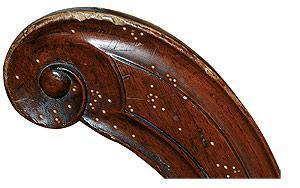Fighting the worms
Post from EditorialsWorm-eaten fornitures, while it shows its age and is, therefore, appreciated by lovers of antiques, hand out a cry of alarm. Fighting the worms with a do it yourself.
The worm-eaten forniture, while it shows its age and is, therefore, appreciated by lovers of antiques, hand out a cry of alarm. 
Indeed the worm-eaten wood, in addition to get uglier, loses consistency and can even get to crumble.
The preferred wood by wood-eating insects is neither too young nor too old: it is dry enough to allow an easy excavation, but it is not too hard.
EWhen the furnitures are antique and already worm-eaten they no longer suffer the attack of insects.
Only a few types of wood are attacked by termites, while others, such as carob and maritime pine, are completely (and fortunately) immune.
Assess the damage of the wood-eaten furniture
If on a piece of forniture only appear old holes, it means that the woodworms have now abandoned the wood and there is no need for further defense, but only of an intervention of restoration of the surface.
If on a piece of forniture there are also "new" holes, this means that some woodworms have left the wood, but others are still at work; in this case we must fight the worms to finally make the wood to become "inhospitable" before proceeding with the final retouch.
The examination of the woodworms holes
 Before any anti- woodworm intervention we need to examine the wood and observe the holes with a magnifying glass.
Before any anti- woodworm intervention we need to examine the wood and observe the holes with a magnifying glass.
If they are clean inside and the edges are well-designed and continuous (1), this means that the woodworms have recentely come out and, probably, other worms are still acting within.
In this case it is necessary to proceed to an intervention of "poisoning" woodworm. 
If, instead, the holes are partially occluded by dust and wax, and the edges are frayed (2), it means that the worms have long ago abandoned the wood and you can directly restore the surface.
Poison the worms
 There are several ways to fight the worms, but note that in any case the fight is long and difficult. An intervention is practicable from anyone when poisoning a layer of wood as deep as possible in order to kill the larvae or adult insects that are hiding.
There are several ways to fight the worms, but note that in any case the fight is long and difficult. An intervention is practicable from anyone when poisoning a layer of wood as deep as possible in order to kill the larvae or adult insects that are hiding.
The poisoning of the wood, also prevents other insects, as a result, to feed from the wood fibers. To obtain this result there are available on the market, liquids of different types, but with similar characteristics.![]() These products are not particularly dangerous to handle with but, being poisons they must be handled with care and kept in places not accessible to children.
These products are not particularly dangerous to handle with but, being poisons they must be handled with care and kept in places not accessible to children.
Before the intervention, the wood should be cleaned so to remove any dirt that would prevent a direct contact with the anti-woodworm liquid. The liquid can be applied on the wood with a brush, with subsequent wipes, while a part of it can be inserted inside the timber by injecting with a syringe, inside the holes of woodworms.
These holes, remember, are output, so that within the insect there is no more, but these galleries are reused by the adult insects to put other larvae, then the intervention is particularly useful. The hole reaches the interior of the wood and allows the liquid to be absorbed from the deeper layers.
The materials needed to take action against the worms: liquid poison, poison spray, cotton, syringe, blacks bags of garbage, filler to close the pores, naphthalene, nylon cloth.

3 - Use the syringe into the holes
Insert the needle of the syringe in all the holes of the forniture and press on the bucket gently until the liquid fills the hole.

4 - Use the syringe even in the cracks of the wood
It should not be limited only to the holes: spray the poison even in the cracks and grain of the forniture to ensure the effect of the poison during time.
5 - Remove the liquid in excess
With a cotton swab, clean the fluid in excess that has leaked: certain types of woodworm poison can stain the wood.
6 - Roll out the poison with a brush
Complete the task of spreading the poison brushing the whole furniture. Two hands are enough.
7 - Use of poison spray
You can also use the spray poison to be injected directly into the holes using the handy dispenser tube. The smaller holes, however, are difficult to treat.
79741 REGISTERED USERS










